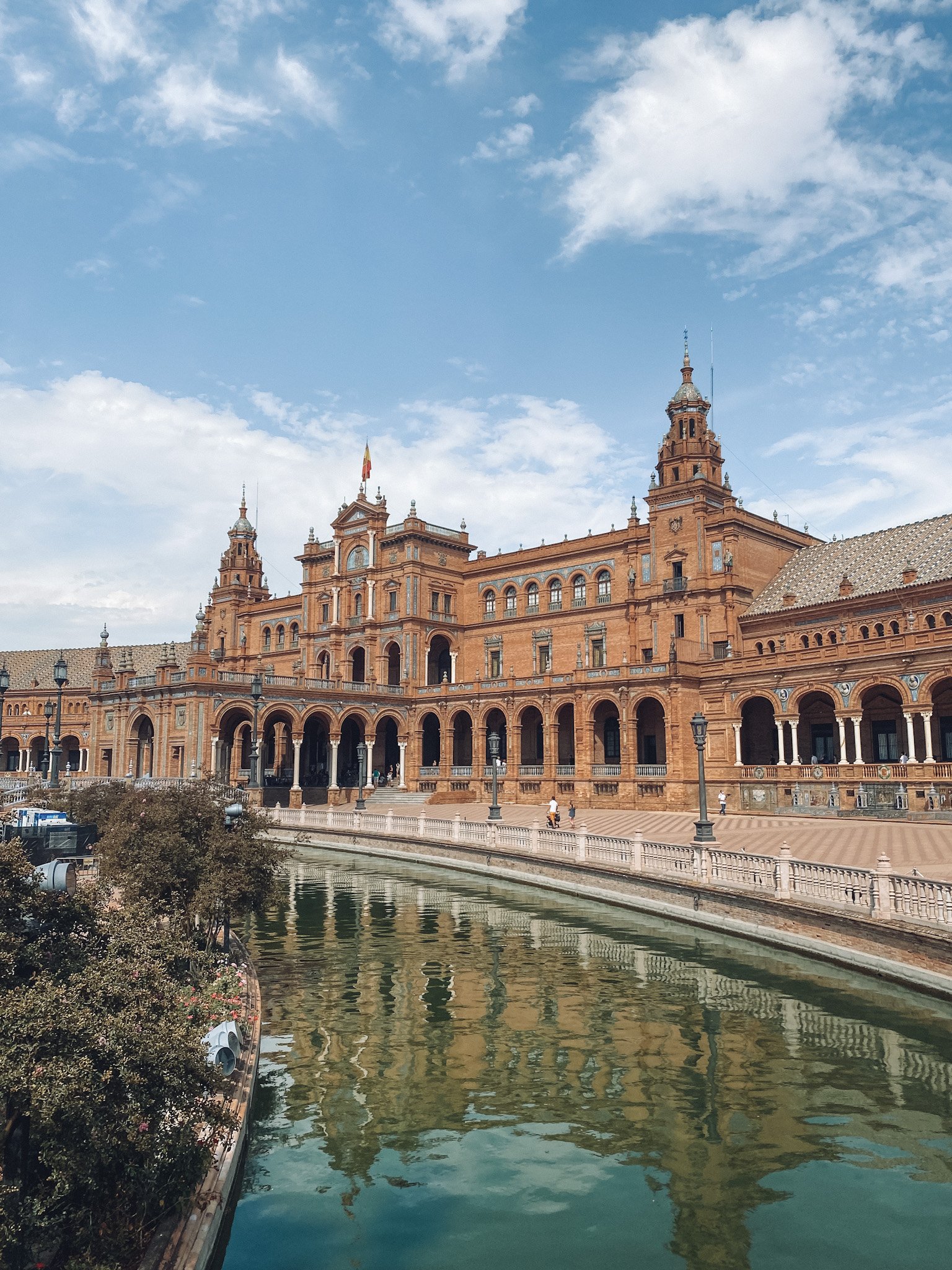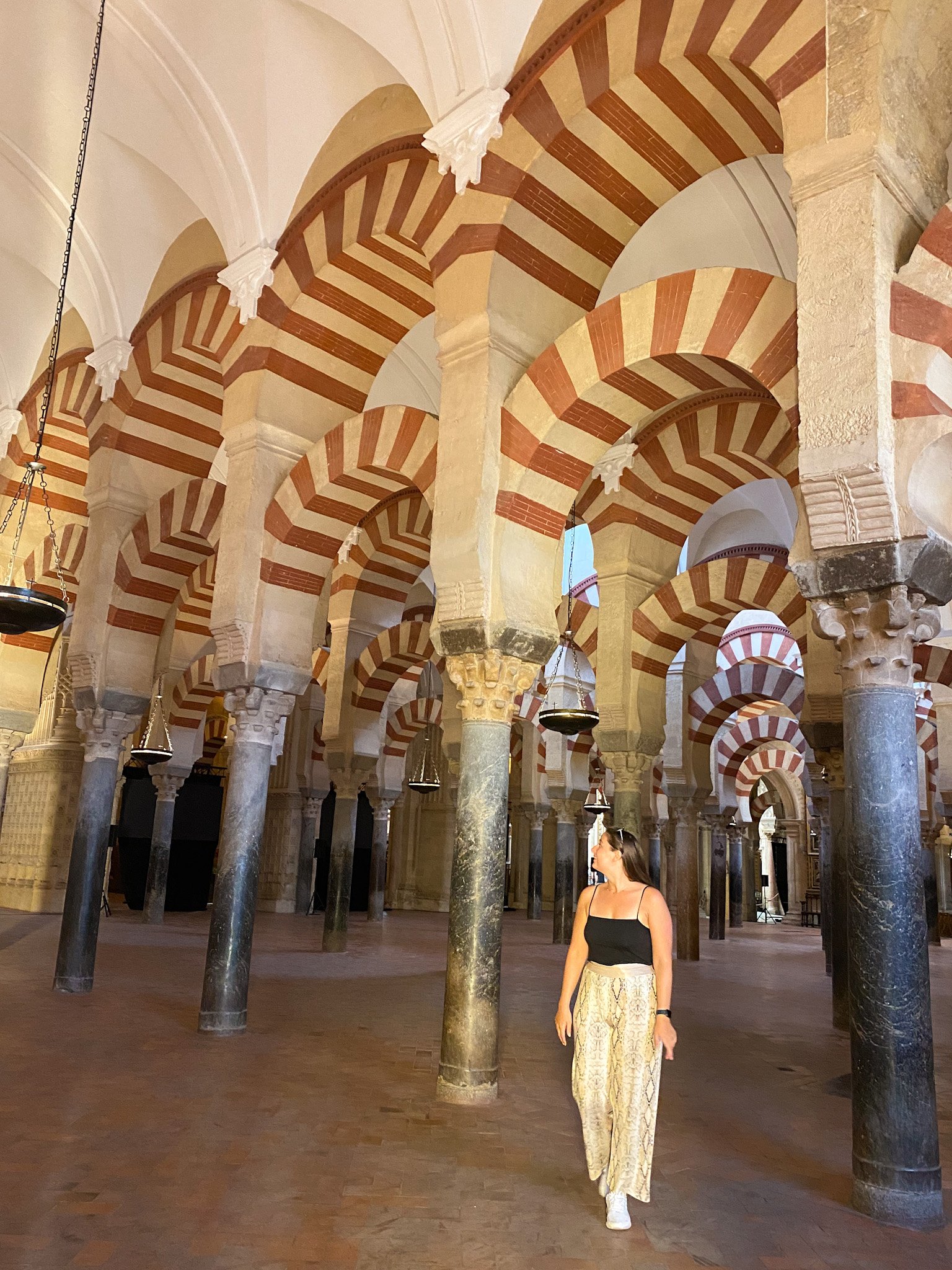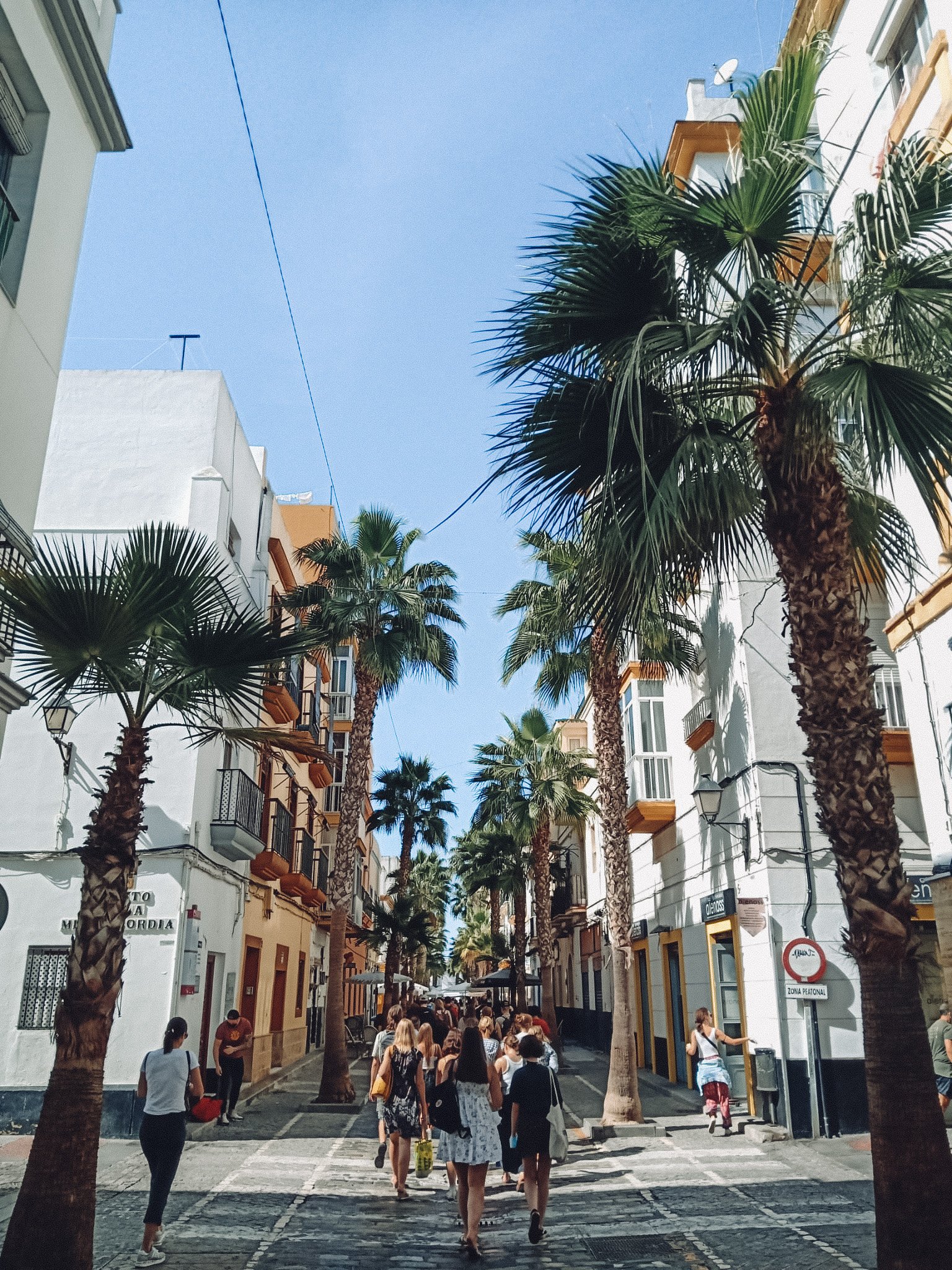7 Days in Andalusia Spain
Andalusia (or Andalucia) is the Southernmost part of Spain. This region is known as the hottest place in Europe. Not only are the temperatures amazing year round, but Seville (Sevilla) the capital of Andalusia was voted number one city to visit by Lonely Planet in 2021. Definitely a must visit area thus. If you only have limited time to explore the region, this 7 day travel guide is perfect for you. During this one week you get to see the best the region has to offer with visits to some of the larger cities, the pueblos blancos and the beaches.
Itinerary: DAY 1 + 2: Seville | DAY 3: Cordoba | DAY 4+5: Granada | DAY 6: Ronda + Pueblos Blancos | DAY 7: Cadiz
Seville
This guide starts of the the capital of Andalusia: Seville. The city is located on the end of the river Guadalquivir in the southwest of Spain. With more than half a million inhabitants this capital city is busy 24/7. It is almost impossible to see everything Seville has to offer in just 2 days, but to make sure your time is best spend, follow this itinerary.
WHERE TO STAY IN SEVILLE:
Hostel: Oasis Backpackers Palace
Hotel: NH Hotels
or get some Airbnb accommodation here.
DAY 1: Alcazar, Giralda & Cathedral
This first day is spent visiting some of the most "popular" sites of the city. No trip to Seville is complete without these. Conveniently these 3 highlights are located only a few minutes walking from each other.
The Royal Alcázar of Seville
Build by the Moorish in the 10th century, the royal palace is known as one of the most beautiful and outstanding art pieces in the mudéjar style. The Alcázar is a mix of Islamic, Gothic and Christian styles as the rulers of the Iberian Peninsula changed throughout the years.
The Cathedral of Seville + Giralda Tower
The Cathedral of Saint Mary of the See, also known as the Seville Cathedral is the largest Gothic Cathedral in the world. With its 124,000 square feet this church is a must visit on your trip to Seville. Throughout the church there are beautiful sights and corners to explore. Adjacent to the church is the Giralda tower. This bell tower was originally built as the minaret for the Mosque of Seville however later it was overtaken by the Christians who added a Renaissance-style belfry.
Shopping + Las Setas
After visiting the highlights for this day, you can relax and explore a bit more of the city center of Sevilla. Go shopping on the main street: Calle Tetatuán. To finish of your evening head over to Las Setas (the Mushrooms) of Seville. This large wooden structure is build in one of the old squares of the city. The construction received a lot of criticism at first as most Sevillanos felt that the structure did not belong in the city. However after a few years more and more people embraced the structure and now it is part of the city. Visiting is best done around sunset as the views from above are amazing at night time.
DAY 2: Plaza De España, River Walk, Triana & Flamenco Show
Your second day in Seville is spend near the River Guadalquivir. A lot of the sights in the city are located quite close and on a nice warm day the breeze by the water is very welcome. The walk takes anywhere between 45 minutes to an hour, however with all the stops it can easily fill a whole morning or afternoon.
Plaza De España & Parque María Luisa
Start of your trip at the Plaza de España one of the most impressive sights in the city. Built in the late 1920'ies for the Ibero-American exposition this plaza represents the mixes of Spanish history and culture. A mix of Baroque Revival, Renaissance Revival and Moorish Revival styles are what make up this impressive square. Continue walking around the Parque María Luisa and enjoy other beautiful monuments as you make your way over to the water.
River Walk & Torre del Oro & Plaza de Toros de la Real Maestranza de Caballería de Sevilla
Next up on this day in Seville is located on the River. First of all is the Torre del Oro (or Golden Tower) a military watch tower in order to protect the city & make sure they would keep control over the river. Free to visit on Mondays this tower is a nice viewpoint over the city. On other days the access is only 3 euros so still worth visiting.
Next up is the Plaza de toros de las Real Maestranza de Caballería de Sevilla (bullring). Although bullfighting is a controversial topic, visiting the ring is worth a visit. You can choose to visit without watching an actual bullfight. However, if you are interested in seeing this spanish tradition shows usually run from April till late September.
Triana
Triana is one of the neighborhoods in Seville, located on the west side of the river. In order to cross from the center to Triana you need to get on the Puente de Isabel II bridge. Once across, there is a large mercado on the right side where you can find traditional tapas such as salmorejo soup, croquettes, and so much more. There is not necessarily a specific place to check out in Triana but if you have the time, make sure to wander around and get lost.
Flamenco Show
Finish your evening with a Flamenco Show, a traditional folklore dance style from the South of Spain. Guaranteed a great show is at the Museo del Baile Flamenco Sevilla. This is a museum where at night you can also watch a show. However there are different places all around the city where you can watch a show.
Córdoba
I recommend staying the night in Sevilla before heading over to Córdoba on the morning of the 3rd day. You can either rent a car for the next part of the trip or travel by train (book your tickets directly through: www.renfe.com). The train ride from Seville to Córdoba takes about an hour (sometimes less sometimes more depending on the train) and about 1h45min by car.
Córdoba is the capital of the province of Córdoba. A unique aspect to the city is that it was not only a major city during the Islamic ruling in the Middle Ages but also a crucial connection point during the Roman Empire. Moreover there are some jewish influences in the city as well. Since Córdoba is not that large, it can be visited in just one day.
DAY 3: La Mezquita-Catedral, Alcázar de los Reyes Cristianos & other sights
La Mezquita-Catedral de Córdoba
The number one reason to visit the city of Córdoba is to visit "La Mezquita". Originally this building was one of the largest mosques in Al-Andalus (muslim controlled region in the Iberian peninsula during the 7th-10th century). Later on in the 13th century, the Christians converted the building into a Cathedral. The building continued to have a more traditional islamic style until later in the 16th-17th century Christian influences were added. La Mezquita is one of the most historical and influential structures in the regions and well worth a visit.
Alcázar de los Reyes Cristianos
The Alcázar served 2 major purposes: fortress of protection & a palace for the royals. This almost perfect rectangular building with 4 prominent towers had a few other purposes throughout the years however it is best known as a palace which was highly loved by the royals. Just like most buildings in Córdoba it combines the styles of Arabic, Christian and Roman style. The beautiful gardens top off the experience and are another reason to visit the Alcázar.
Other Sights
The city has a lot more to offer and many more sights to visit. Make sure to check out this list of places to check out here to make a full day trip tour in Córdoba. At night head over by train (1h30min) or car (2h20min) to the next town: Granada.
Granada
Arriving at night in Granada, enjoy the evening at the hotel or take a stroll through the city center. Granada is located at the foot of the Sierra Nevada mountains. Granada is mainly known for the Alhambra, however when tourists arrive they are surprised by the lively streets, graffiti, monumental churches, and tapas bars. This is why it is suggested to spend 2 days in the city.
WHERE TO STAY IN GRANADA:
Hostel: ECO hostel
Hotel: NH Hotels
or get some Airbnb accommodation here.
DAY 4: Exploring Granada & the Alhambra
The Alhambra & Generalife Gardens
Like mentioned before, the number one reason people head on over to Granada is to see the Alhambra. The fortress was constructed in 9th century as a small defense post, and mainly ignored until around the 11th century when it started to be reconstructed. In the 14th century the Arab Dynasty finalized construction and turned the Alhambra into a palace. After the Spanish Reconquista the place became the Royal Court. The Alhambra is worth visiting to not only understand its history but also adore its culture and art. The Generalife Gardens are located on the hill Cerro del Sol next to the Alhambra and was known as a place where the royals could relax and get away from official tasks at the palace.
Granada Cathedral & Royal Chapel of Granada
The Cathedral of Granada was built over a period of 181 years (16th-18th century). It was built as a "celebration" of Christianity after 600 years of Muslim ruling. Throughout the years of building the church had 18 architects who all had individual styles, the biggest change during construction was when shifting from Gothic to Renaissance style. Next to the Cathedral, the Royal Chapel can be found. This is the final resting place of Queen Isabella I and King Ferdinand.
DAY 5: Albaicín & Hammam Experience
The Albaicín (Albayzín)
This neighborhood in Granada still shows a bit of the old Moorish influences with its narrow streets. The houses are mainly built over a hillside and provide magnificent views over the city and the Alhambra. Being that it is about 30 minutes walking from the city center of Granada, Albaicín feels like a little corner in the city with its own food and drinks.
Hammam Experience at Al Andalus
Hammam Al Andalus is one of the first Arabic Baths to reopen after the Spanish banned them over 5 centuries ago. At the Hammam you can enjoy relaxing Turkish baths, get a massage and relax. This Hammam still has a lot of its old and original architecture and design. Located in the middle of the city center it is ideally located and usually the lines are not too long. If you want to be sure you can book an experience as well.
Shop at the Alcaiceria
The Alcaiceria used to be the big bazaar from during the Islamic-Arabic times. Now it remains to be a shopping area with small markets and shop owners. Unfortunately due to a fire a lot of the bazaar was destroyed. The city of Granada had it rebuilt, but it never returned to its old scale, only a small part still exists.
After finishing the day in Granada head on over to the Pueblos Blancos (White Villages). If you are traveling by train your visit might be limited to only Ronda unless you get on a tour. However, for those traveling by car I suggest spending the night in one of the surrounding white villages (eg Grazalema) and explore Ronda during the day.
Ronda + Pueblos Blancos
One of the highlights when visiting Andalusia is a visit to the White Villages (Pueblos Blancos). Located in the Northern part of the Cadiz and Malaga province are a few White Villages that have mind blowing views over the Sierra de Grazalema Natural Park.
WHERE TO SPEND THE NIGHT:
Hostel: Virgen del Rocio
Hotel: Hotel Don Miguel
or get some Airbnb accommodation here.
DAY 6: Ronda + Pueblos Blancos
Depending on where you decide to spend the night the order of the villages might be switched up. If you do not have the access to a car, I highly suggest looking into booking a group tour to the different villages.
Ronda
One of the most famous towns in this area is Ronda. The mountaintop village is located in the Malaga province. It is most famous for its dramatic gorge and amazing views. When visiting make sure to walk down the main pathway to get the views of the bridge Puente Nuevo. Another famous landmark in the city is the bullring. The city is nice to explore however in a few hours you have seen most it has to offer.
Setenil de Las Bodegas (the city under the rock)
Another pueblo that is worth visiting is the city under the rocks: Setenil de Las Bodegas. The city is quite literally located underneath the rocks. It is a very unique city and definitely worth a visit. If you have the freedom of traveling by car I recommend heading over to this town in the late afternoon early evening. As most tourist busses leave around this time, you have the city for yourself to explore.
Grazalema
Although Grazalema is only a very small town, it has quite a nice atmosphere and enjoyable views. You can also do a hike around this pueblo to really feel like you are up in the mountains. It is also a great place to sleep if you are spending the night (and have a car). There is not anything in particular to visit in this town other than the nice white houses and streets like the other pueblos blancos.
Zahara de la Sierra
The last pueblo that you HAVE to visit is Zahara de la Sierra. It is one of the most beautiful of the white villages out there. Located on the top of a mountain it overlooks the valley and man-made lake. I highly suggest driving from Grazalema to Zahara de la Sierra and stop at some of the viewpoints to get the magnificent views over the lake & mountains.
Cádiz
For your final day travel from Ronda (or another pueblo) to Cadiz. The car ride takes about 2 hours and if traveling by train is about 4 hours (as you need to have a stop in Seville). For those who don't want to make the journey over I suggest just returning to Seville. However, for those who want to have a relaxing day by the beach; Cadiz is the place to be.
WHERE TO STAY IN CADIZ:
Hostel: Planeta Cadiz
Hotel: Playa Victoria
or get some Airbnb accommodation here.
DAY 7: Cadiz, Explore + Beach
Cádiz City Center
Start the day of with some time in the city center to visit some of the highlights. When visiting you cannot miss out on seeing the Cathedral, Teatro Romano, La Caleta beach & the Mercado. If you want to make the most of your morning, I suggest booking a walking tour. This way you get to see most of the city and get a little bit more insight as well on the history of the city.
The Beaches of Cádiz
One of the main reasons people go to Cádiz is to spend some time at the beach. There are many beaches in the city. Some are located near the rest of the sights, however most of them are located on the tourist strip which is a bit of a walk/drive out of the city center. It is the perfect way to end your 7 day adventure in Andalusia.
























































